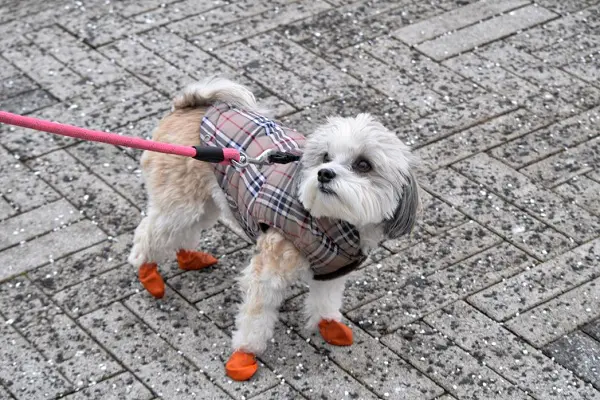Dog boots can protect a dog’s paws from hazards such as hot pavement, sharp objects, and chemical substances. They can also provide traction on slippery surfaces and prevent foot injury from excessive licking or biting.
Additionally, dog boots can help to prevent the spread of dirt and debris in the house and protect floors and furniture. Some dog boots are also designed for specific activities such as hiking or hunting. Overall, dog boots can provide many benefits for the health and well-being of a dog.
Have you ever observed a dog wearing boots? If you have, you surely know how cute and funny it looks. But, the question is whether it’s necessary or useful for them or just another accessory for decoration.
In this blog, we will discuss the usage and effectiveness of dog boots.
- Weather friendly
- Benefits of Dog Boots
- Procedure to select boots for dogs
- Should dogs wear shoes in winter?
- Does my dog need shoes for summer?
- Conclusion
- Subscribe to Our Newsletter
Weather friendly
Whatever the season- summer to the winter-the dog must go for a walk. But bad weather conditions may confuse you to take them outside. Because in extreme temperatures, their highly delicate paws may develop irritation in them.
Especially in the winter season, when the dog goes walking, snow may cause maximum damage. In this situation, dog boots are one of the solutions.
Benefits of Dog Boots
Dog boots are in high demand, which may look fussy for you. But for a highly active dog, it’s mandatory. Like humans, their paws are highly-sensitive, and there are high chances of injury if your dog participates in increased physical activity in rough temperatures.
For running and hiking on rough terrain, using boots is mandatory. It also protects the paws from injury, frostbite, and burn. In addition, an injured foot heals faster if kept dry and clean, so it’s better to cover this area from moisture and dirt. Boots are ideal for this situation.
Furthermore, it keeps the delicate paws of your pet safe from ice. In some regions, de-ice proves effective in melting the ice.
However, de-ice reacts with paws and can cause burns. Also, there is a high chance of your dog licking the paws’ chemicals. Apart from this, salt also leads to skin irritation. However, boots help to prevent all these risks.
If your surrounding is too hot, using a boot is obvious, especially if the terrain is without grass or made of concrete. That may burn the surface of the paws and damage the sensory nerves. So, wearing boots ensure good protection for dog paws.
The idea behind wearing boots is that it can be detailed and hard to hike and walk through the forest, especially in rough terrain.
Choosing a proper boot will help solve this issue for the canine. In addition, some dogs are prone to grass allergies. So, even if the boot can’t prevent pollen, it can make a barrier against direct contact with grass.
Procedure to select boots for dogs
How do you select the boot for the size of the paws? The best way will be to take them to the shop. Get a trial for the right one, and then make the purchase. If that’s not possible, measure the paws on paper as we measure ours.
There must be some space in your measurements for the nails to ensure they don’t prick their nails or scratch the shoe. The boot measurement should consider the legs also. Else, it may get too loose that it can lose.
Boots are available in different types in the market. For example, dog boot is available in 2 pairs (a combination of four). Plastic-made boots are the oldest boots available on the market.
It makes your dog feel too dry, but there is a high chance of getting lost. Leather boots come fabricated with a single piece of leather with two holes in the central paws. They are usually preferable for hunter dogs.
Doggie socks or fabric boots can also be an ideal option. It has a leather sole knitted and has legs made of elastic. Hence, these can protect from ice, mud, and clay.
Fabric boots made of nylon are the best option. It consists of Velcro for adjustment, which is best for ice. Nylon doesn’t wet much, and fleece gives warmth.
Should dogs wear shoes in winter?
Dogs can benefit from wearing shoes during the winter to protect their paws from cold temperatures, snow, and ice. Cold weather can cause a dog’s paws to dry and crack, and prolonged exposure to snow and ice can lead to frostbite.
Dog shoes can also provide traction on slippery surfaces and prevent injury from salt and other chemicals that melt ice on sidewalks and roads.
Additionally, dog shoes can help to prevent the spread of snow and salt in the house and protect floors and furniture. However, it’s important to note that not all dogs need shoes, some breeds have thick fur on their paws that protects them from cold and ice, and some species are used to living in cold temperatures.
It’s best to consult with your veterinarian or a professional dog trainer to see if your dog would benefit from wearing shoes in the winter.
Does my dog need shoes for summer?
- Protects paws from hot pavement, sharp objects, and chemical substances
- Provides traction on slippery surfaces
- Prevents injury from broken glass or other sharp objects
- It helps to prevent the spread of dirt and debris in the house
- Protects floors and furniture
- Not all dogs need shoes, and some breeds have thick paw pads that can withstand the heat.
- Consult with a veterinarian or a professional dog trainer to see if your dog would benefit from wearing shoes during the summer.
Conclusion
Not all dogs need boots; some breeds have thick fur on their paws that protects them from cold and heat, and some species are used to living in these temperatures. Therefore, it’s best to consult a veterinarian or a professional dog trainer to see if your dog would benefit from wearing boots during hot or cold weather.
 Dog Street – Best Dogs Website In India | All Dog Latest News Portal
Dog Street – Best Dogs Website In India | All Dog Latest News Portal



